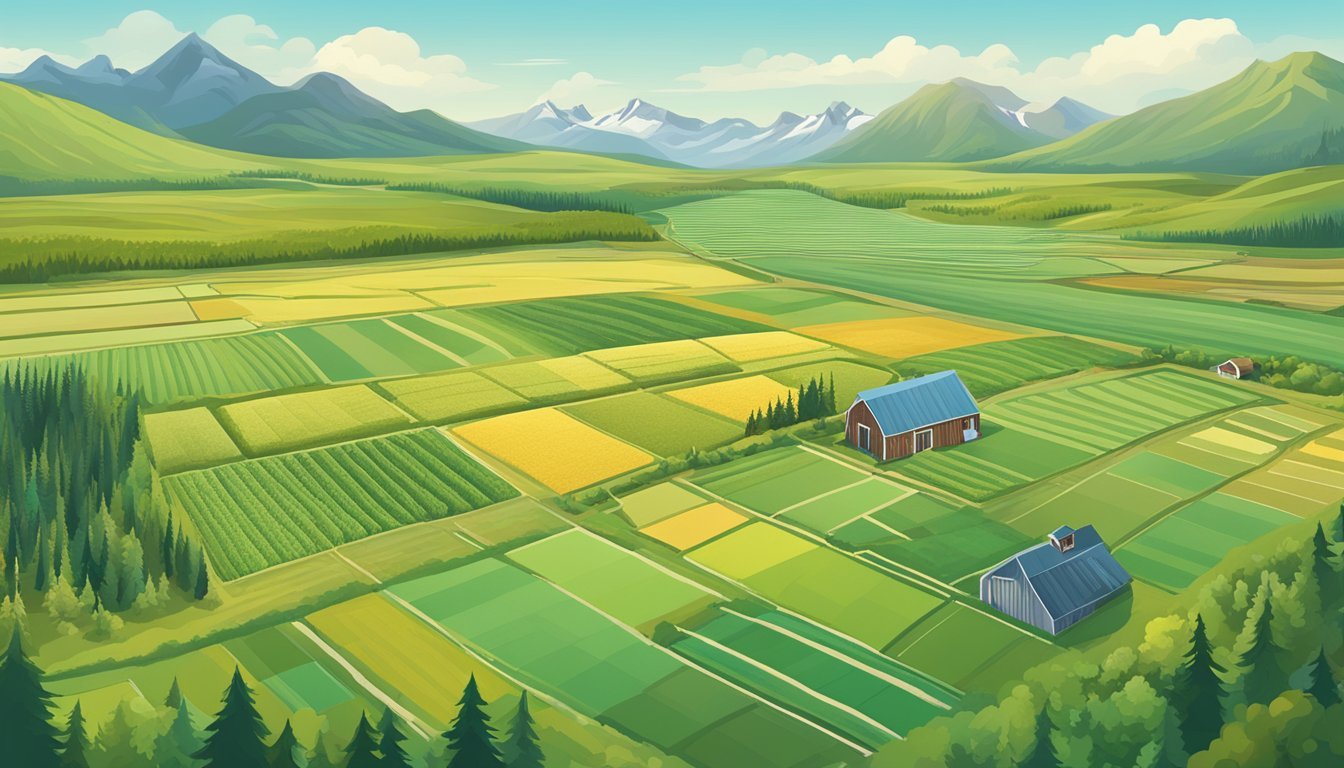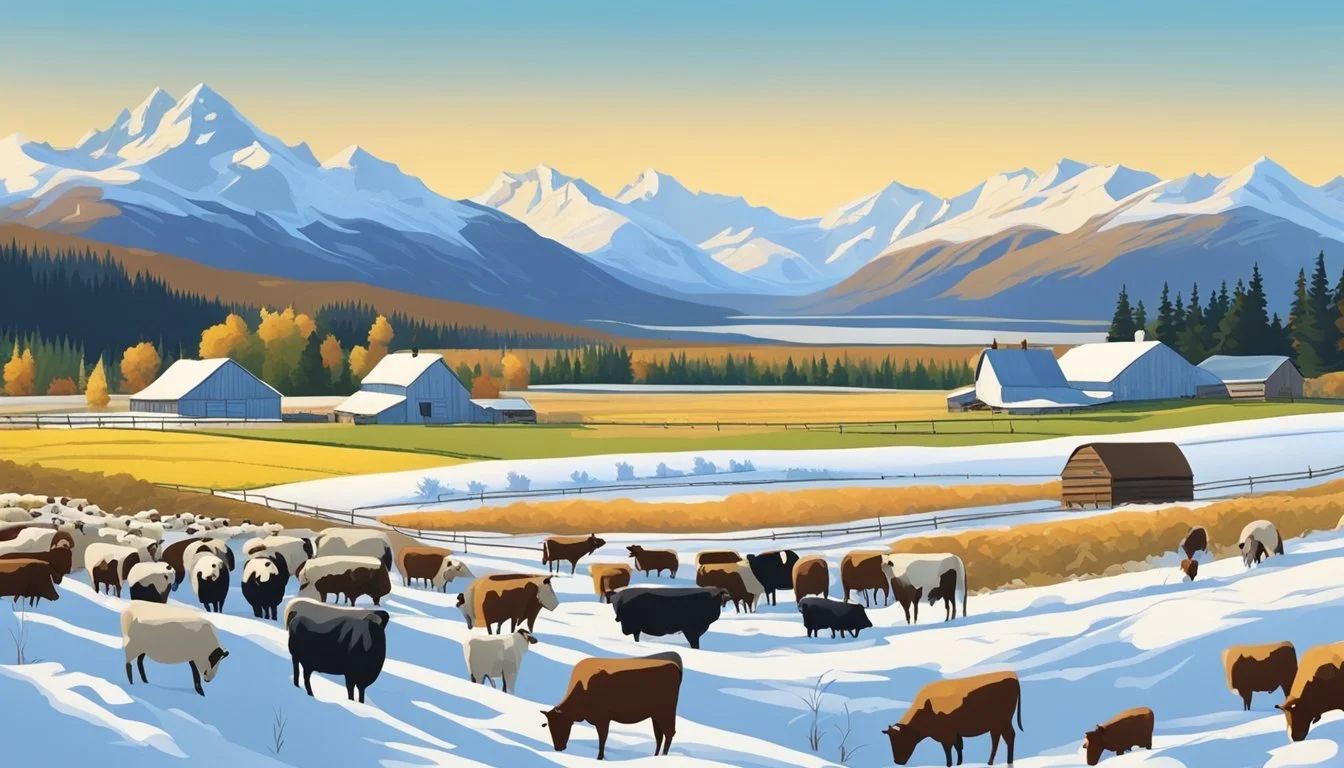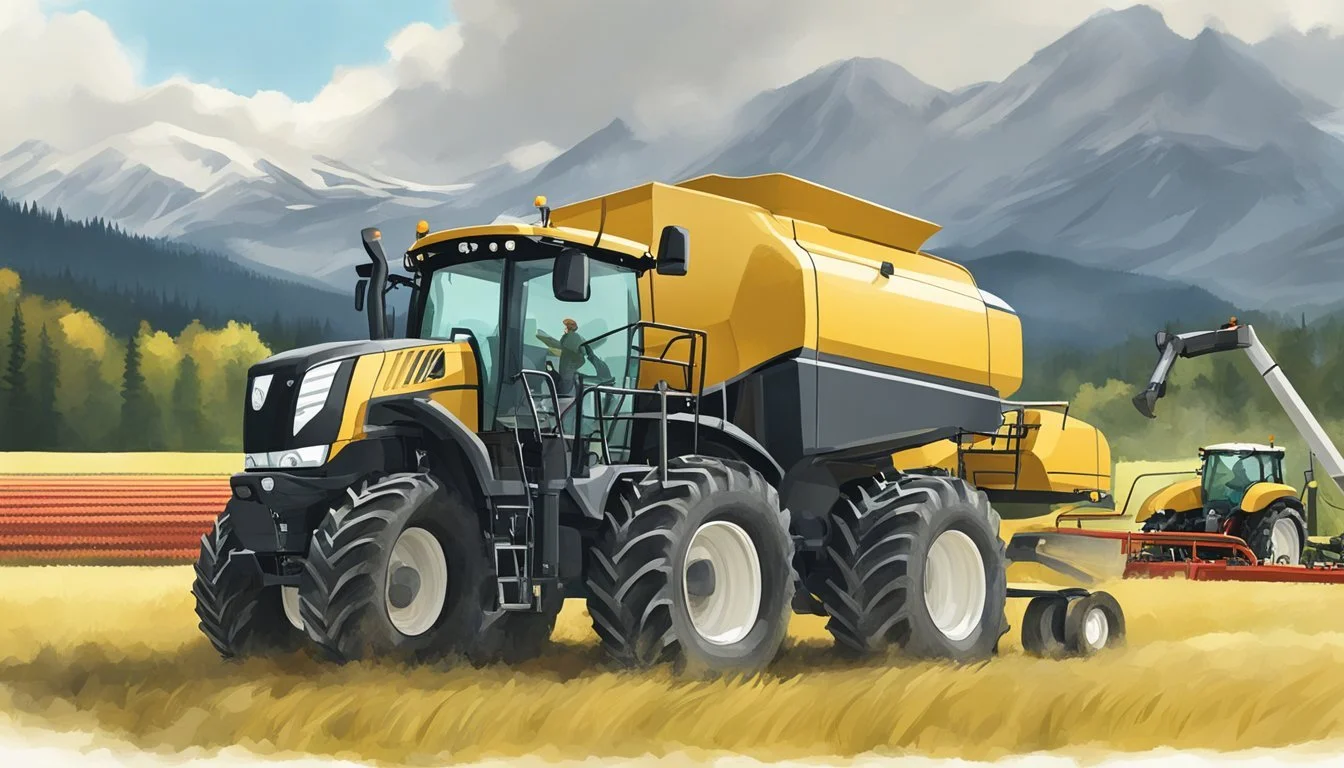Right to Farm Law in Alaska
Understanding Agricultural Protections
The Right to Farm law in Alaska serves as a legal shield for agricultural facilities and operations from nuisance lawsuits, the type that might arise as residential patterns shift and urban or suburban development encroaches on traditional farming areas. Established to support and maintain the viability of the state's agricultural sector, the law asserts that a farm or agricultural operation cannot be deemed a nuisance if it has been operating consistently with a soil conservation district plan and was not a nuisance at its inception.
In addition to protecting existing agricultural operations, Alaska's statutes reflect a commitment to preserving the agricultural heritage of the region. By limiting the ability of new residents or land developers to challenge farming practices, the law recognizes the importance of agriculture to the state's economy and cultural identity. This legislation is echoed in some form across all fifty states, underlining the nationwide recognition of farming's critical role.
Alaska's approach to the Right to Farm is rooted in both historical practices and contemporary legal standards. As developments in land use and environmental regulations continue to evolve, state law provides a framework to balance the interests of farmers and their neighbors, establishing clear legal precedents to navigate conflicts. This stability is crucial for the state's agricultural producers, who require certainty in the legal landscape to operate effectively and plan for the future.
Historical Context of Right to Farm Laws
Right to Farm laws were established as a legal framework to protect agricultural activities from nuisance lawsuits and urban encroachment. They have become a foundational aspect of agricultural law in the United States.
Development of Right to Farm in Alaska
Alaska established its Right to Farm law in 1986, which is codified in the Alaska Statutes at Section 09.45.235. The law was designed to secure the rights of farmers by declaring certain agricultural operations as not constituting private nuisances, thus providing them with immunity from nuisance lawsuits. This was an important step in recognizing the significance of farming in the state and protecting existing agricultural operations from the pressures of incoming non-farming neighbors.
The passing of this legislation has coincided with a substantial 83% increase in the number of farming operations, indicating its impact on the agricultural community in Alaska. However, it's also noted that the total acres dedicated to farmland have decreased by 17%, which underscores the complexity of agricultural development within the state.
Comparison with Other States
While Alaska's Right to Farm law is an important part of the state's approach to agricultural operations, it is one among many in the United States. Let's examine how it compares to a selection of other states:
Arizona: Arizona's Right to Farm laws are outlined in Arizona Revised Statutes, Title 3, Chapter 3, Article 2.1.
Florida: Florida Statutes, Title XLVI, Chapter 823, contains regulations related to farm operations.
Georgia: Provisions for agricultural operations and nuisances can be found in Georgia Code, Title 41, Chapter 1.
Virginia: Virginia's Right to Farm Act is described in the Virginia Code, Title 3.2, Chapter 21.
West Virginia: In West Virginia, Right to Farm laws are found in the Code of West Virginia, Chapter 19, Article 30.
Each state has tailored its laws to cater to its unique agricultural landscape, balancing the needs of growth, development, and environmental concerns. The National Agricultural Law Center provides resources that further delve into these statutes, offering comparisons at both state and federal levels. It is evident that while all of these laws serve a common purpose to support farmers and promote agricultural stability, the specifics of the legislation vary to reflect regional priorities and challenges.
Legal Framework
Alaska's Right to Farm Law provides a legal shield for agricultural operations, aimed at protecting them from nuisance lawsuits, particularly due to urban encroachment on farming areas.
Key Provisions of Alaska's Right to Farm Law
The Right to Farm Act in Alaska is designed as a defense mechanism for farmers against nuisance lawsuits stemming from standard farming operations. It was enacted in 1986 to encourage agricultural development by curbing legal conflicts between rural landholders and incoming urban residents. Under this act, farming operations that conform to generally accepted agricultural practices and are established prior to surrounding non-agricultural activities are entitled to protection.
Notable provisions include:
Protection from nuisance claims for existing operations changing ownership, size, or type.
Farms are not shielded from lawsuits if they disregard state and federal environmental laws.
Newcomers to an agricultural area cannot claim nuisance against longstanding operations.
Statutory Language and Interpretation
The crux of Alaska's Right to Farm legislation is found in Alaska Statutes Section 09.45.235. The statutory language used in the legislation clarifies what constitutes an agricultural operation, including aquatic farming, and outlines what is recognized as a legitimate farming practice. The precise interpretation of phrases like "agricultural facility" become pivotal in court cases, dictating the scope of protections offered.
Statutory schemes: The Act's language is interpreted by the courts based on traditional legislative understanding, balancing the interests of the agricultural sector with those of the public.
Role of the Alaska Supreme Court
The Alaska Supreme Court plays a vital role in the interpretation of the state's Right to Farm Act. In disputes over the application of the act, the Court's decisions set precedents that shape the boundaries of the law. It scrutinizes the statutory language and evaluates each case against both state-specific statutes and relevant federal law. This process ensures a consistent legal application across Alaska, leaving a lasting impact on both the agricultural community and residential neighbors.
Legal Precedents: Case rulings from the Alaska Supreme Court set important legal precedents that interpret the Right to Farm laws in relation to nuisance claims and outline the balance between state and private interests.
Right to Farm Protections
In Alaska, Right to Farm laws offer vital legal shields for farmers and their agricultural operations, anchoring their role in a changing landscape amidst evolving neighboring developments.
Protected Farming Operations
The scope of the Right to Farm protections in Alaska specifically includes a diverse range of agricultural activities. These operations encompass traditional crop production as well as livestock rearing. Additionally, Alaska acknowledges the importance of other related agricultural practices by covering timber harvesting, slaughtering, processing, and manufacturing within the ambit of protected farming operations. All are deemed vital to the state's agricultural infrastructure.
Protected entities include:
Crop production: Fields for growing grains, vegetables, fruits, and more.
Livestock: Facilities for raising animals such as cows, pigs, and poultry.
Timber harvesting: Areas allocated for logging activities.
Slaughtering and processing: Establishments where livestock is processed.
Manufacturing related to agriculture: Facilities involved in converting raw agricultural products into goods for consumption or use.
Protection Against Nuisance Lawsuits
Alaska’s Right to Farm law provides a defense against nuisance lawsuits for established agricultural operations. As long as an agricultural operation was not a nuisance at its inception and complies with a soil conservation district plan, it cannot be deemed a private nuisance. This legal provision acknowledges the reality of farms in existence prior to surrounding non-agricultural developments and supports their continuity in face of complaints from newer residents or businesses who may not be accustomed to the realities of living near a working farm.
Limitations and Exclusions
However, there are limitations and exclusions to the protections provided by Right to Farm laws. Not all agricultural activities are automatically shielded and must meet certain standards. Operations must not have been a nuisance from the start, which implies that farms must operate within the bounds of the law and conform to acceptable agricultural practices, especially with regards to environmental regulations. Furthermore, any significant changes to the operation or expansions are assessed to ensure they do not introduce new nuisance factors that were previously absent.
Key Limitations:
Initial Nuisance Status: Operations must not have been a nuisance when they began.
Compliance: Continuous conformity with soil conservation and environmental guidelines is required.
Operational Changes: Alterations to farming operations are subject to review for nuisance potential.
Implications for Farm Owners
Alaska's Right to Farm Law significantly impacts the operations and legal standing of farm owners. It offers clarity and protections against nuisance lawsuits while also presenting certain challenges that necessitate careful consideration.
Benefits for Farmers and Ranchers
Alaska’s Right to Farm Law provides a layer of protection for farmers and ranchers. It defends their agricultural facilities and operations from nuisance lawsuits related to changes in the surrounding area, under the condition that the operations were not nuisances at their inception.
Preservation of Agricultural Interests: Farm owners benefit from a legal framework that recognizes the value and importance of their contributions to society and the economy.
Operation Consistency with Soil Plans: If farmers' operations are consistent with a soil conservation district plan, their property is safeguarded against being declared a private nuisance.
These aspects ensure that farmers and ranchers can carry out their operations with a measure of security and predictability.
Challenges and Criticisms
While the Right to Farm Act aims to protect farmers and ranchers, it is not without its critics. Concerns arise when the interests of the community and farm operations come into conflict.
Balancing Interests: Farm owners must navigate the intricate balance between the operational needs of their farms and the interests of their neighbors.
Potential for Dispute: If disputes arise, farmers have to be prepared to demonstrate that their operations align with conservation plans and that they did not constitute a nuisance when they began.
Farmers and ranchers have to be attentive to these challenges to maintain positive relationships with the surrounding community while ensuring the viability of their operations.
Land Use and Property Rights
The legislation known as the Right-to-Farm Law in Alaska has significant implications on land use and property rights, influencing the dynamic between agricultural and residential interests, contributing to farmland preservation, and dictating the framework for private property and nuisance claims.
Balancing Agricultural and Residential Interests
Alaska's Right-to-Farm (RTF) Law primarily serves as a safeguard for farmer rights, allowing agricultural activities to continue free from certain legal challenges. As urbanization pushes residential development closer to farming operations, the RTF Law aims to prevent new homeowners from filing nuisance lawsuits against existing agricultural uses of the land. This balance seeks to ensure that farmers can maintain their livelihoods without the threat of closure due to influxes of non-farming residents who might object to commonplace farming activities like raising livestock or the noise from machinery.
Farmland Preservation
The introduction of the RTF Law correlates with a marked change in Alaska's agricultural landscape: an 83% increase in the number of farming operations alongside a 17% decrease in the acres of farmland. This highlights the law's role in not only protecting, but also potentially encouraging the subdivision of existing farmland. The objective here is to maintain farmland for its intended use. As noted in Alaska Statutes AS 29.45.060, farmland is to be assessed based on its value for farm use, not as if it were to be subdivided for nonfarm purposes.
Private Property and Nuisance Claims
Under Alaska's RTF Law, codified at Alaska Stat. §09.45.235, agricultural operations are protected from private nuisance claims to a certain degree. The statute implies that typical farming activities, even when considered a nuisance by nearby residents, cannot easily constitute a legal nuisance. Essentially, if a farm was in operation before the establishment of adjacent residential properties, its practices are afforded a degree of legal immunity from nuisance lawsuits. This legislative protection is a reflection of the state's commitment to preserve agricultural interests against the pressures of residential development and other nonfarm uses of land.
Environmental Considerations
Alaska's Right-to-Farm laws interface significantly with environmental regulations, particularly in the context of air and water quality and the use of agricultural chemicals and sewage sludge.
Impact on Air and Water Quality
Agricultural operations in Alaska must consider the impact on air and water quality. Farm odors, chemical runoff, and animal manure can affect neighboring communities and ecosystems.
Odors: Farming activities can generate odors that, while typical of agricultural operations, might impact nearby residential areas.
Chemical Runoff: When pesticides and herbicides are not managed properly, they can contaminate surrounding water bodies, negatively affecting water quality.
Animal Manure: If not properly handled, animal manure can leach into waterways, contributing to nutrient overload and subsequent algal blooms that can deplete oxygen in aquatic environments.
Use of Pesticides and Sewage Sludge
The use of pesticides and sewage sludge in agriculture is regulated due to their potential to harm the environment.
Pesticides:
There is strict oversight regarding the application of herbicides and pesticides to safeguard both the agricultural land and nearby habitats.
Farmers must adhere to guidelines meant to minimize chemical drift and groundwater contamination.
Sewage Sludge:
Sewage sludge is sometimes used as a fertilizer, but it can contain harmful pathogens and hazardous chemicals.
Guidelines ensure its safe application, preventing the transfer of contaminants to crops and the surrounding environment.
Each practice is subject to federal and state regulations designed to protect both the agricultural community and the natural resources of Alaska.
Technological Advances and Farm Practices
Technological advancements in farming practices have shaped the operational landscape, driving efficiencies and changing the legal framework surrounding agricultural operations, notably amidst Right to Farm statutes.
Adoption of New Technology
Farmers in Alaska are integrating new technologies across various aspects of their operations. These include precision agriculture tools that allow for more efficient use of resources, as well as advanced storage systems and manufacturing facilities that enhance food processing and preservation. For instance, the application of drones and satellite imaging contributes to more precise field monitoring and crop management. In aquatic farming, technologies assist in monitoring water quality and fish health, fostering sustainable aquaculture practices.
Effects on Right to Farm Statutes
The integration of innovative technologies has had a direct impact on Right to Farm statutes. Modern farm equipment and practices can sometimes lead to disputes when they are unfamiliar to non-agricultural communities, potentially resulting in nuisance lawsuits. Alaska's Right to Farm laws aim to protect farmers from such lawsuits, ensuring that agricultural operations, including those that adopt new technologies, can thrive without the undue pressure from nearby residents unacquainted with farming activities. As technology evolves, these statutes may require updates to reflect current practices, ensuring that both traditional and technologically advanced farming operations are equally protected under the law.
Legal Actions and Defenses
In the context of Alaska's Right to Farm Law, legal actions and defenses focus on protecting agricultural operations from certain nuisance lawsuits, while balancing the interests of neighboring property owners. This involves the careful navigation of litigation and the application of legal precedent by skilled attorneys.
Navigating Nuisance Lawsuits
Alaska's Right to Farm Law codified at Alaska Statutes Section 09.45.235 provides a defense to farmers against private nuisance claims. Typically, a nuisance lawsuit arises when an individual alleges that a farm's operations create unreasonable interference with the use and enjoyment of their property. Under this statute, if farmers are operating within the confines of state law and regulations, they have a legal shield against nuisance claims. Historical precedents suggest that the law favors longstanding farming operations over newer developments in proximity to these farms.
Role of Attorneys and Legal Precedent
Attorneys play a vital role in interpreting Right to Farm statutes and in defending agricultural operations against nuisance lawsuits. Notably, they examine the specifics of each case, such as the operational history of the farm and relevant state regulations, to determine whether a defense under the Right to Farm Law is applicable. Previous cases, like that of Robert Riddle, who employed the Right to Farm defense in a litigation in Alaska, and the involvement of attorneys such as Eric Lanser, reflect the law's complexities. Attorneys must discern whether claims of nuisance are brought in bad faith or if they are groundless, as the law may protect the farmer if litigation is deemed to be frivolous or intended to harass.
Financial and Economic Aspects
The Right to Farm Laws in Alaska have tangible financial implications, influencing both the revenue streams for farmers and the broader agricultural economy.
Economic Impact of Right to Farm Laws
The implementation of Right to Farm laws in Alaska has been significantly tied to both the growth and resilience of the agricultural sector. Since these laws came into effect in 1986, they have provided a degree of economic stabilization to farming operations by offering protection against nuisance lawsuits. This legal assurance encourages investment in farm businesses, as farmers have a lower risk of costly litigation when neighboring non-farming residents might otherwise complain about typical farm operations.
Farming in Alaska is diverse, including dairying, sod farms, hay and crop production, and the growing of potatoes. Right to Farm laws support the economic viability of these operations by allowing them to function without the constant threat of lawsuit-based disruptions. This has been particularly beneficial for the 83 percent increase in the number of farming operations, even in the face of a 17 percent decrease in farmland acres.
Grants and Support Programs for Farmers
Financial assistance and support programs are critical for the development of Alaska's agricultural sector. Various grants and funding opportunities enable farmers to sustain and develop their operations, with a focus on enhancing profits and ensuring economic growth. For instance, farmers may access funds for technological improvements, infrastructure development, or expanding into new agricultural markets, which directly affects the profitability of their farms.
Such programs provide vital resources to ensure the longevity and health of farms, reinforcing their capacity to contribute to the state's economy. By buffering farmers against the financial impact of nuisance claims and supporting agricultural best practices through educational programs, Alaska's Right to Farm laws and related support initiatives help maintain a robust farming economy.
Community and Social Dynamics
Right to Farm laws in Alaska shape the interactions between agricultural operations and the surrounding communities, balancing interests and governing land use.
Farmer-Neighbor Relations
Alaska’s Right to Farm (RTF) laws serve as a critical framework for maintaining harmony between farmers and their neighbors. These laws protect farmers from nuisance lawsuits, which may arise as residential areas expand into traditionally agricultural lands. In practice, when individuals relocate from urban to rural areas, they may be unaccustomed to the realities of farm life, leading to potential conflicts. The RTF law helps to preserve the viability of existing farms by safeguarding them from complaints related to regular farming activities.
Impact on Farmers:
Protection from nuisance lawsuits
Ability to maintain agricultural operations without new neighbor interference
Impact on Neighbors:
Clear expectations set about living near farming operations
Encouragement to understand the agricultural nature of their new community
Role of Municipalities and Local Governance
Municipalities and local governance bodies play a pivotal role in the implementation and enforcement of RTF laws within the state. These entities are tasked with the careful consideration of land use regulations, ensuring that agricultural uses are appropriately classified and protected. The local governance must balance the interests of the state, the farming community, and non-farming residents to foster a community supportive of both agricultural and non-agricultural development.
Responsibilities of Municipalities:
Classifying land use to align with RTF laws
Mediating disputes between farmers and non-farming residents
Planning for rural and urban development with RTF laws in mind
The interplay between RTF laws, farmers, and neighbors, mediated by local authorities, underscores the complex social dynamics within Alaskan communities. Through these laws and governance, Alaska seeks to promote a stable and prospering agricultural sector alongside responsible community growth.
Future Directions and Policy Considerations
The right to farm legislation in Alaska faces ongoing scrutiny and evolution tailored to accommodate an ever-changing agricultural landscape. The policymakers and researchers concerned with these provisions must balance the interests of farmers, neighbors, and the environment.
Potential Reforms and Amendments
It is essential for legislation to evolve to stay relevant and useful. In Alaska, potential reforms could focus on clarifying the language of the current statutes to ensure they properly protect modern agricultural practices while respecting the rights of neighboring properties. Policy experts suggest that specific amendments may need to address emerging agricultural technologies and practices that were not anticipated when the original laws were drafted. For qualifying farmers, a clear and updated statute can provide legal certainty and reduce the risk of nuisance lawsuits.
Table: Suggested Legislative Amendments for Alaska's RTF Laws
Amendment Type Description Anticipated Impact Clarification Refine definitions related to farming operations. Reduce ambiguity in legal disputes. Environmental Concerns Integrate considerations of environmental impact. Balance farm operations with sustainability. Technology Inclusion Update the statute with modern farming technologies. Protect novel farming methods under RTF provisions.
Emerging Trends in Farming and Right to Farm
The intersection of emerging trends in farming and the Right to Farm laws is crucial for future policy considerations. Gene editing, vertical farming, and renewable energy usage within agriculture are trends that may soon require special attention in the context of Right to Farm laws. Researchers must conduct thorough research and publication efforts to guide policymakers in crafting regulations that reflect these advancements. As agriculture in Alaska progresses, it becomes increasingly vital for Right to Farm policies to be versatile, supporting innovation while safeguarding existing farming operations and their neighbors.
Resources and Information
This section provides a thorough collection of resources and legal texts related to Alaska's Right-to-Farm Law, as well as educational tools and research opportunities for in-depth understanding and analysis.
Compilation of Resources and Legal Texts
For individuals seeking comprehensive legal resources, the National Agricultural Law Center presents a robust repository. Interested parties can find the full legal text of Alaska Statute §09.45.235 within the Center's research publications, reflecting updates through all regular and special legislative sessions up to 2021. Moreover, the Center offers a detailed chart or map outlining state-specific Right-to-Farm laws that allow for comparative analysis.
Key Resource: National Agricultural Law Center Research Publication
Legal Text: Alaska Stat. §09.45.235
Additional Tools: Comparative Chart/Map of Right-to-Farm Statutes by State
Educational Tools and Research Opportunities
Educators, researchers, and stakeholders benefit from the array of educational tools and research opportunities available. Publications such as Right to Farm 101 for Aquaculture Stakeholders in Alaska delve into specifics, including legislative history and the inclusion of aquatic farming in Alaska's agricultural definition.
Key Tool: "Right to Farm 101 for Aquaculture Stakeholders in Alaska" (Publication)
Source for Updates:
Legislation News
Academic Studies
State Department of Natural Resources - Division of Agriculture
Research Focus: Agricultural & Food Law Consortium
Through these resources and tools, individuals are equipped with the necessary information to understand and engage with the Right-to-Farm laws in Alaska, fostering a more informed dialogue on agricultural and aquacultural matters.














